
 Data Structure
Data Structure Networking
Networking RDBMS
RDBMS Operating System
Operating System Java
Java MS Excel
MS Excel iOS
iOS HTML
HTML CSS
CSS Android
Android Python
Python C Programming
C Programming C++
C++ C#
C# MongoDB
MongoDB MySQL
MySQL Javascript
Javascript PHP
PHP
- Selected Reading
- UPSC IAS Exams Notes
- Developer's Best Practices
- Questions and Answers
- Effective Resume Writing
- HR Interview Questions
- Computer Glossary
- Who is Who
Lymphatic System: An Overview
What is Lymphatic System and How Does it, Work?
Within the human body, there is a system that works as a drainage network helping to keep the fluids balanced while also helping to fight against infections. This network is called the lymphatic system which works with the circulatory system. The lymphatic system is mainly involved in the removal of excess fluid from the body tissues and returning it to the bloodstream.
Hence the lymphatic system is a subsystem for the both circulatory and immune systems. Lymphatics are usually present all over the body except the areas like CNS, bone, teeth, cartilage, and epithelium.
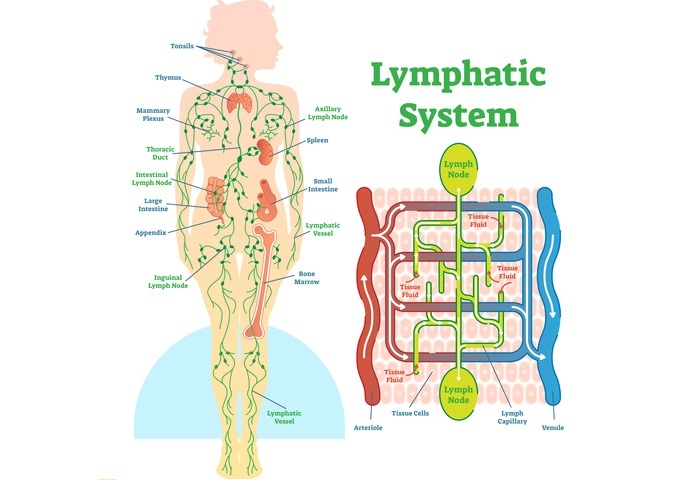
Circulatory system, whose major function is to bring oxygen and nutrients to body tissues and also to remove wastes. The exchange mentioned here occurs usually in capillaries which are the small blood vessels.
Blood plasma which contains the nutrients released out of the capillaries at the arterial end of capillary beds. Tissue fluid usually differs from blood plasma by the presence of white blood cells called leukocytes in plasma. Most of the tissue fluid is reabsorbed into the capillary vessels through venules.
However, a small amount of this liquid will not return to the blood capillary system. This amount of fluid which comprises about 15% is left in the tissues and would result in swelling or edema if gets accumulated. The lymphatic system then comes into play as it mops up the excess fluid and returns it to the bloodstream of the circulatory system.
Unlike the circulatory system, which is a closed one, the lymphatic system is a one-direction open-ended network of vessels.
Components of the Lymphatic System
Structurally the lymphatic system consists of below main components.
Lymph
It is a watery interstitial fluid that flows through the entire lymphatic system. Once the interstitial fluid enters the lymphatics it is referred to as lymph. Lymph moves the same as blood in capillaries. It also moves from capillaries to larger and larger vessels and finally drains the fluid into the blood through the subclavian vein.
It may contain proteins, excess fluid, and pathogens from tissues and the interstitium. Much of the lymph starts with the blood plasma which gets forced out through the capillaries into the capillary beds where the leakage helps in exchanging the nutrients and gases between the blood and tissues.
Blood capillaries reabsorb some of the fluid but a lot is left behind, the lymphatic system then takes the fluid back to its place by inspecting it all along the way.
Lymph Nodes
These collect the lymph from the lymphatic vessels and act as checkpoints that monitor and cleanse the lymph before reaching the bloodstream. As lymph nodes contain macrophages and dendritic cells, these lymph nodes mount immune responses against the pathogens inside the lymph by engulfing them.
Lymph nodes also contain T and B lymphocytes which are involved in the adaptive immune response which results in the production of activated lymphocytes and antibodies specific to the pathogens. These nodes are small-shaped enlargements found at various points including the neck, armpits, groin, and the walls of the intestines. There are about 600-700 lymph nodes in the human body. Lymph nodes are most prominent in the areas where the vessels converge.
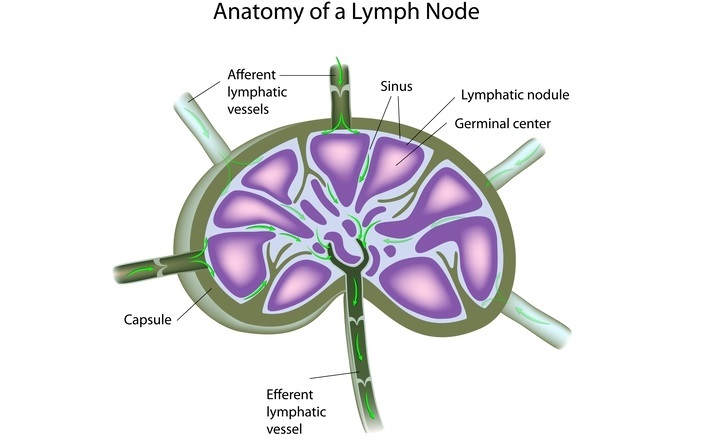
Lymphatic Vessels and Capillaries
Lymphatic vessels begin as the lymphatic capillaries. These are made up of overlapping endothelial cells. The overlapping flaps function here as a one-way valve. When the fluid gets accumulated in the tissue, interstitial pressure pushes the flaps inward thereby gaps between the cells increase allowing the fluid to flow in.
When the pressure inside the capillaries increases, endothelial cells are pressed outward closing the gaps and preventing the backflow of the liquid. Unlike blood capillaries, the gaps in lymphatic capillaries are large allowing pathogens and immune cells like macrophages inside.
Hence the lymphatic system is a useful way for allowing large particles reaching the blood. Lymphatic capillaries unite to form collecting vessels that move along the arteries and veins before emptying lymph into one of the many lymph nodes found in the body.
There are two types of lymphatic vessels which include
Superficial lymphatic vessels found in subcutaneous tissue which accompany veins and these vessels drain the lymph to the deep lymphatic vessels.
Deep lymphatic vessels are found in deeper tissues and accompany the arteries. These vessels receive internal organ drainage.
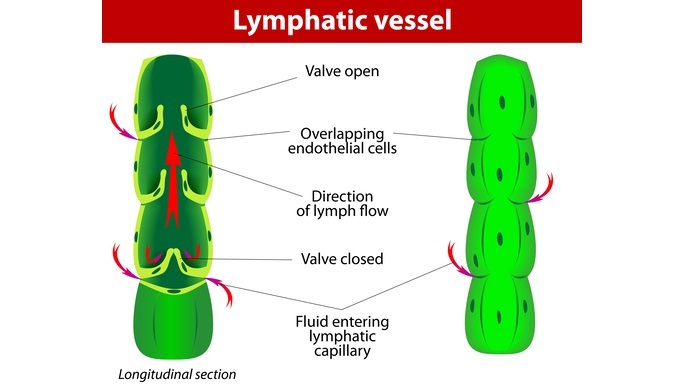
Lymphoid Organs: Lymphatic system also includes:
Primary Lymphoid Organs (thymus and bone marrow) - These are the sites of lymphocyte production, maturation, and selection. In the selection process, the lymphocytes learn to distinguish between self-particles and foreign antigens so that it recognizes and eliminates only the non-self but do not attack the self.
Secondary Lymphoid Organs (spleen, lymph nodes, lymphoid nodules) - Mature lymphocytes leave the primary lymphoid organs and enter secondary organs. These lymphocytes encounter pathogens in these organs and get activated to produce an immune response.
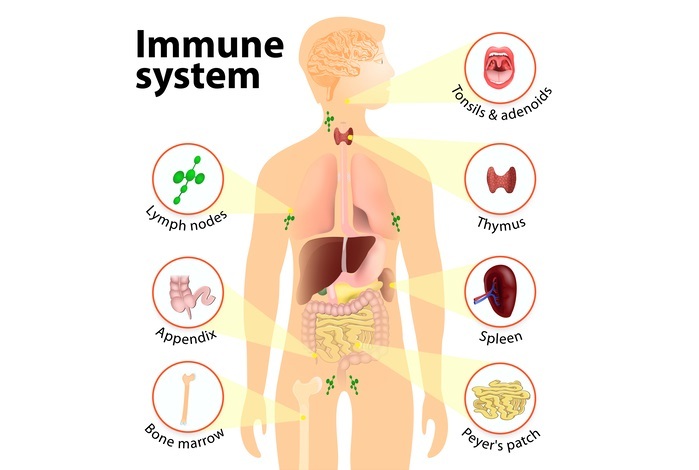
Functions of the Lymphatic System
In addition to carrying lymph, the lymphatic system has additional functions.
In the small intestine, lymphatic vessels known as lacteals absorb fatty acids and transport fat into the circulatory system.
By draining the extra fluid from the tissues, the lymphatic system helps prevents swelling and brings fluid back to the bloodstream.
Lymphatic system acts as one wat drainage system transporting fluid from body tissues into blood circulation.
These get rid of the waste products produced by the cells.
It produces immune responses through the production of lymphocytes and monocytes.
It has white blood cells which help to fight infections.
Lymphatic system maintains homeostasis by eventually returning most of the fluid back into the blood. Failure of this leads to swelling, lungs get filled with fluids, Bp drops to the point that body gives up and finally leads to death.
Lymphatic system has a series of checkpoints that can handle small infections on the spot and if they cannot handle these system alerts the entire body to take down that infection.
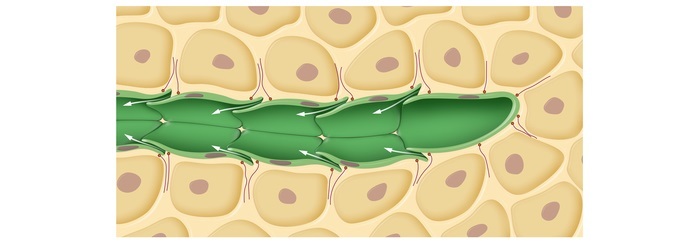
Conclusion
The lymphatic system plays a major role in providing support for both the circulatory and immune systems. The lymphatic system collects the extra fluid that is squeezed out of the blood capillaries and sends it back to the bloodstream after filtering the lymph fluid and eliminating its pathogens, in the lymph node.
Lymph nodes which is an important lymphoid organ are involved with the production of lymphocytes that helps the body by providing adaptive immunity.
So lymph nodes are the ones that inspect the lymph by its resident immune cells B and T lymphocytes. Usually, lymphocytes are matured in loose reticular connective tissue which makes up a large part of the nodes. Enlarged lymph nodes are an early diagnostic sign of any disease or infection.

